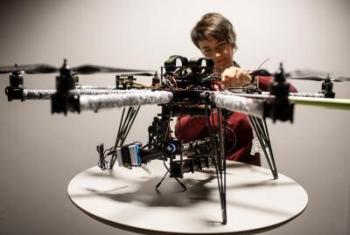May 16 2013
Geologists have long used seismology on the bottom of the ocean or have been throwing dynamite from snowmobiles when they look for oil. But now researchers at Centre for integrated petroleum research (CIPR), a joint venture between the University of Bergen (UiB) and Uni Research, have found a new preferred method – using drones to map new oil reserves from the air.
 Researcher Aleksandra Sima at Bergen's Centre for Integrated Petroleum Research (CIPR) is part of the Norwegian research team using drones to look for oil. (Photo: Eivind Senneset/UiB)
Researcher Aleksandra Sima at Bergen's Centre for Integrated Petroleum Research (CIPR) is part of the Norwegian research team using drones to look for oil. (Photo: Eivind Senneset/UiB)
- In reality the drones can be viewed as an advanced camera tripod, which helps geologists to map inaccessible land in an efficient manner. The use of drones facilitates our efforts to define the geology and to find oil, says researcher Aleksandra Sima at CIPR about the drone that she and her fellow researchers have just acquired to take aerial shots of rocks.
Virtual fieldwork
Sima is a member of CIPR's Virtual Outcrop Geology (VOG) group. The group's main task is to create digital maps in 3D of potential oil fields. Using laser scanners, infrared sensors and digital cameras, the researchers create realistic, virtual models. Every tiny pixel of an image can store information on minerals and rocks.
These high-tech models help the geologists to criss-cross the landscape, not unlike what you will find on Google Earth. This virtual fieldwork enables the researchers to gather information on anything from the type of rock to the thickness of the sedimentation; all with the help of a few mouse clicks on the computer.
- A landscape's surface often reflects what lies beneath ground and corresponds with the rocks below the seabed. When we have an overview of the rocks and minerals in one area, it is far easier to make estimates about where to find oil and how the oil flows, says Simon Buckley, senior researcher at CIPR and head of the VOG group.
Quick and affordable
So far, the researchers have used ground-based laser scanners (LIDAR), infrared sensors and cameras to replicate the landscape. But putting instruments on the ground is both time-consuming and limited to lower ground areas.
In higher elevations in the shadows of sensors, for instance behind rocks or high mountains, the researchers have had to mount the cameras and laser sensors to helicopters, which they have leased.
- Using drones is more affordable. All places can be reached quickly and you can shoot in inaccessible areas, Buckley explains.
Pictures shot with the help of a drone complement the images from low-level terrain that the researchers already have in hand. The end result is more precise and complete 3D models.
- The aim is to bring all models together to get the best possible geological map of an area, says Buckley.
The use of drones in the search for oil is similar to techniques used in Switzerland and Germany to look for minerals. The models created by the CIPR researchers can also be used for research on CO2 storage.
- It isn't hard to collect a point cloud of laser readings and present these. The challenge is to use the data for geological analysis, Buckley points out.
A helicopter in the office
The drone is operated from the ground just like a radio-controlled plane, shooting images of the earth's surface from the air. The pilot on the ground also operates the camera.
There are plenty of restrictions in place, though, and not anyone can fly a drone. Norwegian aviation authorities put strict regulations on anyone wanting to use drones for research. Aleksandra Sima has been practising in a flight simulator and has tested mini helicopters in her office.
- The worst thing that can happen is that a drone crashes and hurts people, says Sima before reassuringly adding.
- But we won't be flying drones in populated areas.